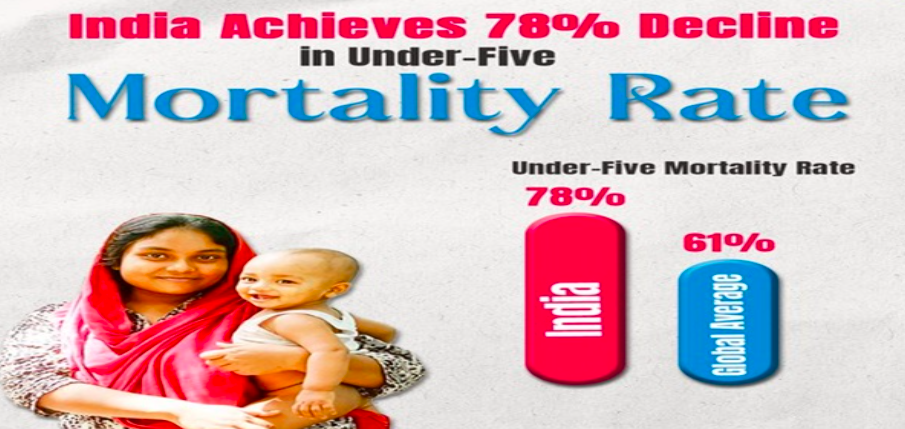India has recorded one of the major successes in the field of public health as its death rate under the age of five has reduced by 78 per cent compared to 61 per cent by the rest of the world as stated in the United Nations Inter-agency Group for Child Mortality Estimation (UN IGME) 2024 report. The country report published on March 25, 2025, indicates how India has silently changed lives of the young people and provides other countries with an exemplary powerful case.
The reduction in the number of deaths among under-fives was registered in decades. India has achieved a lot in the past 23 years and more so in the current century. There was a decrease in the number of deaths per 1,000 live births (48 to 28) as well as a decrease in neonatal mortality (by 39 per cent, 28 to 17 per 1,000 live births) during 2015-2023. Such increases are based on previous efforts; the difference in the under-five rate in India since 2000 is 70 per cent, and it has been achieved through the steady and concerted efforts.
In the rest of the population of over 1.4 billion people in India, gaps still exist but there has been obvious progress in many areas. More people in rural regions and urban settlements as well as the marginalized populations receive better access to medical care. Schemes like Ayushman Bharat, the largest health insurance scheme in the world, have provided health insurance to millions of families particularly in underserved regions of the country and made sure that remote regions too get the essential support.
India has been successful in health due to political will, evidence-based plans and the consistent expenditure in health facility. It has prioritised child survival in the country by addressing the causes of infant death that are preventable; that is, prematurity, pneumonia, diarrhoea, and measles. The United Nations IGME report describes India as an exemplary country since they adopt a holistic practice. This involves better health systems, increase in immunization coverage, and also they enhance the maternal and newborn care standard. As an illustration, in 2000, infants were vaccinated against measles at the rate of 56 per cent which increased to 93 per cent by 2023 reducing under-five deaths of measles by 97 per cent to 5,200. Other programs such as National Nutrition Mission (POSHAN Abhiyaan) and Anemia Mukt Bharat act against malnutrition and anemia where child deaths are a cause.
There have been multiple intertwined steps towards the advancement of India and those steps include policies, improved infrastructure, and community engagement. Such significant steps are: Stronger Health Systems: Maternity waiting homes, newborn stabilization units, and sick newborn care units are some of the new ways that improve the access of mothers and babies to quality care when they are most needed. Under the Ayushman Bharat scheme, free delivery, medications and diagnostics will be available thus providing equal access to healthcare. Increased Immunization Programs: Good coverage of immunization against such diseases as measles, diphtheria, and tetanus reduces deaths caused by infectious diseases. Members of the community health staff provide education and vaccinations to the distant regions.
Evasive Strategies and Countermeasures: India has used data to focus on populations at higher risk, particularly in rural and low income areas. The UN IGME report highlights the importance of evidence-based decision-making in order to ensure that resources go to people who are most in need. Community Based Care: Accredited Social Health Activists (ASHAs) and other community level workers have also made up for the decline in delivery of health care services by visiting homes, advocating nutrition, healthy breastfeeding and hygiene practices. Innovative Financing: Initiatives such as Ayushman Bharat ensure financial sustainability of the health coverage by financing costs for millions of households, thereby reducing out of pocket expenditure and access to critical services.
When commitment, investment, and action cooperate, 78 per cent reduction of under-five mortality proves the case of India compared to the world average (61 per cent). The UN IGME study, sponsored by UNICEF, WHO and World Bank views the experience of India as a model to other countries. Nevertheless, there are obstacles, such as imbalance in rural areas and weak environments. India not only saves millions of children who will grow up healthy, the results of which will be reflected in the number of new families with children growing up healthily, but it also contributes to the construction of a new future as a miracle of later life.











Add Comment